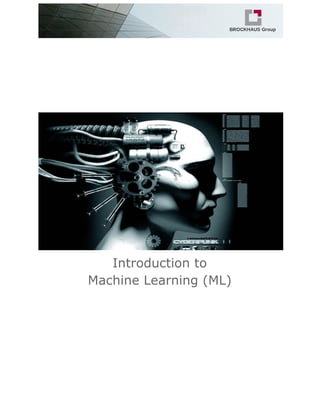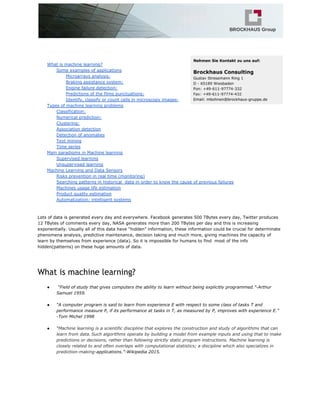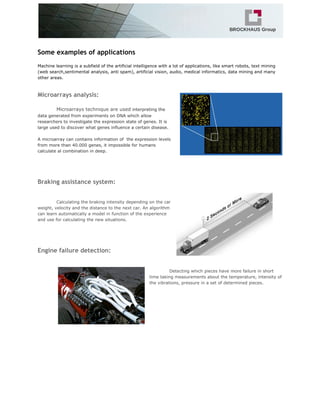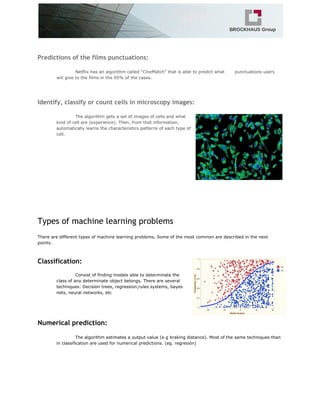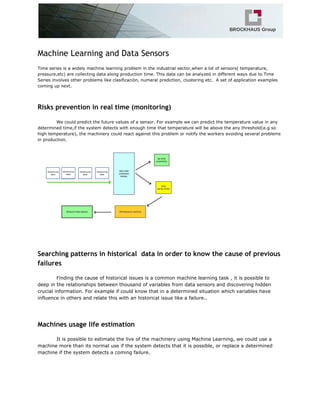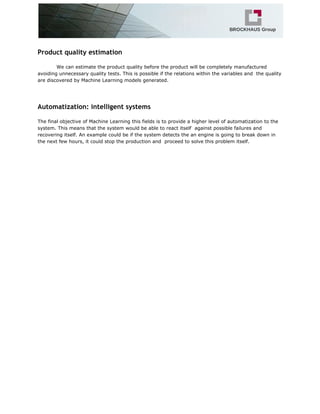Intro 2 Machine Learning
- 1. Introduction to Machine Learning (ML)
- 2. What is machine learning? Some examples of applications Microarrays analysis: Braking assistance system: Engine failure detection: Predictions of the films punctuations: Identify, classify or count cells in microscopy images: Types of machine learning problems Classification: Numerical prediction: Clustering: Association detection Detection of anomalies Text mining Time series Main paradigms in Machine learning Supervised learning Unsupervised learning Machine Learning and Data Sensors Risks prevention in real time (monitoring) Searching patterns in historical data in order to know the cause of previous failures Machines usage life estimation Product quality estimation Automatization: intelligent systems Lots of data is generated every day and everywhere. Facebook generates 500 TBytes every day, Twitter produces 12 TBytes of comments every day, NASA generates more than 200 TBytes per day and this is increasing exponentially. Usually all of this data have “hidden” information, these information could be crucial for determinate phenomena analysis, predictive maintenance, decision taking and much more, giving machines the capacity of learn by themselves from experience (data). So it is impossible for humans to find most of the info hidden(patterns) on these huge amounts of data. What is machine learning? ● “Field of study that gives computers the ability to learn without being explicitly programmed.”-Arthur Samuel 1959. ● “A computer program is said to learn from experience E with respect to some class of tasks T and performance measure P, if its performance at tasks in T, as measured by P, improves with experience E.” -Tom Michel 1998 ● “Machine learning is a scientific discipline that explores the construction and study of algorithms that can learn from data. Such algorithms operate by building a model from example inputs and using that to make predictions or decisions, rather than following strictly static program instructions. Machine learning is closely related to and often overlaps with computational statistics; a discipline which also specializes in prediction-making-applications.”-Wikipedia 2015.
- 3. Some examples of applications Machine learning is a subfield of the artificial intelligence with a lot of applications, like smart robots, text mining (web search,sentimental analysis, anti spam), artificial vision, audio, medical informatics, data mining and many other areas. Microarrays analysis: Microarrays technique are usedinterpreting the data generated from experiments on DNA which allow researchers to investigate the expression state of genes. It is large used to discover what genes influence a certain disease. A microarray can contains information of the expression levels from more than 40.000 genes, it impossible for humans calculate al combination in deep. Braking assistance system: Calculating the braking intensity depending on the car weight, velocity and the distance to the next car. An algorithm can learn automatically a model in function of the experience and use for calculating the new situations. Engine failure detection: Detecting which pieces have more failure in short time taking measurements about the temperature, intensity of the vibrations, pressure in a set of determined pieces.
- 4. Predictions of the films punctuations: Netflix has an algorithm called “CineMatch” that is able to predict what punctuations users will give to the films in the 95% of the cases. Identify, classify or count cells in microscopy images: The algorithm gets a set of images of cells and what kind of cell are (experience). Then, from that information, automatically learns the characteristics patterns of each type of cell. Types of machine learning problems There are different types of machine learning problems, Some of the most common are described in the next points. Classification: Consist of finding models able to determinate the class of any determinate object belongs. There are several techniques: Decision trees, regression,rules systems, bayes nets, neural networks, etc Numerical prediction: The algorithm estimates a output value (e.g braking distance). Most of the same techniques than in classification are used for numerical predictions. (eg. regresión)
- 5. Clustering: The clustering objective is to group objects determined by similar characteristics or patterns.(e.g news) At the end, each cluster determined a class, but these classes are not previously defined. Association detection Aims in finding associations or correlations of interest in a set of transactions, usually represented by rules. e.g recommendation system in only shopping Detection of anomalies An anomaly or outlier is an input that not matches with the general behavior of the data. E.g engine failure detection, intruders detections, etc. Text mining Is the process of extract useful information from texts. Text mining usually involves the process of structuring the input text,deriving patterns within the structured data, and finally evaluation and interpretation of the output. Eg: classify an opinion in negative or positive. Time series In this type of problem the algorithms treat with multiple variables with values along of the time.(e.g,data from temperature sensors in a engine) The aim is to find patterns in the historical data. (e.g, if the temperature influences the pressure in a critical moment) This kind of problems also are frequently use in business for market predictions.
- 6. Main paradigms in Machine learning Supervised learning This kind of learning is carrying out on classification or numeral prediction tasks. On these tasks, each case is divided in input values and output values that are what the algorithm determines. E.g: ➢ input: cell image ➢ output: kind of cell. In supervised learning we have training set for each input, an it output. The algorithm uses this information with corrected classifications to construct a model.When a new input that we don't know its class,the model predicts what class this input belongs. Unsupervised learning In this case, we don't have previous knowledge. The algorithm algorithm does not have info about the outputs.It has its onw metrics to determinte patterns. Clustering is a clear example of unsupervised learning.
- 7. Machine Learning and Data Sensors Time series is a widely machine learning problem in the industrial sector,when a lot of sensors( temperature, pressure,etc) are collecting data along production time. This data can be analyzed in different ways due to Time Series involves other problems like clasificación, numeral prediction, clustering etc. A set of application examples coming up next. Risks prevention in real time (monitoring) We could predict the future values of a sensor. For example we can predict the temperature value in any determined time,if the system detects with enough time that temperature will be above the any threshold(e.g so high temperature), the machinery could react against this problem or notify the workers avoiding several problems in production. Searching patterns in historical data in order to know the cause of previous failures Finding the cause of historical issues is a common machine learning task , it is possible to deep in the relationships between thousand of variables from data sensors and discovering hidden crucial information. For example if could know that in a determined situation which variables have influence in others and relate this with an historical issue like a failure.. Machines usage life estimation It is possible to estimate the live of the machinery using Machine Learning, we could use a machine more than its normal use if the system detects that it is possible, or replace a determined machine if the system detects a coming failure.
- 8. Product quality estimation We can estimate the product quality before the product will be completely manufactured avoiding unnecessary quality tests. This is possible if the relations within the variables and the quality are discovered by Machine Learning models generated. Automatization: intelligent systems The final objective of Machine Learning this fields is to provide a higher level of automatization to the system. This means that the system would be able to react itself against possible failures and recovering itself. An example could be if the system detects the an engine is going to break down in the next few hours, it could stop the production and proceed to solve this problem itself.
